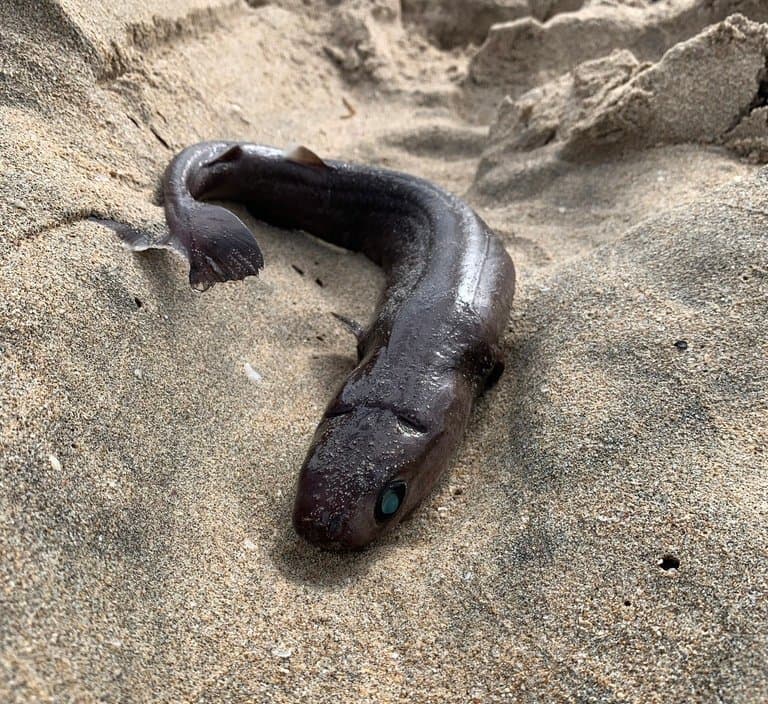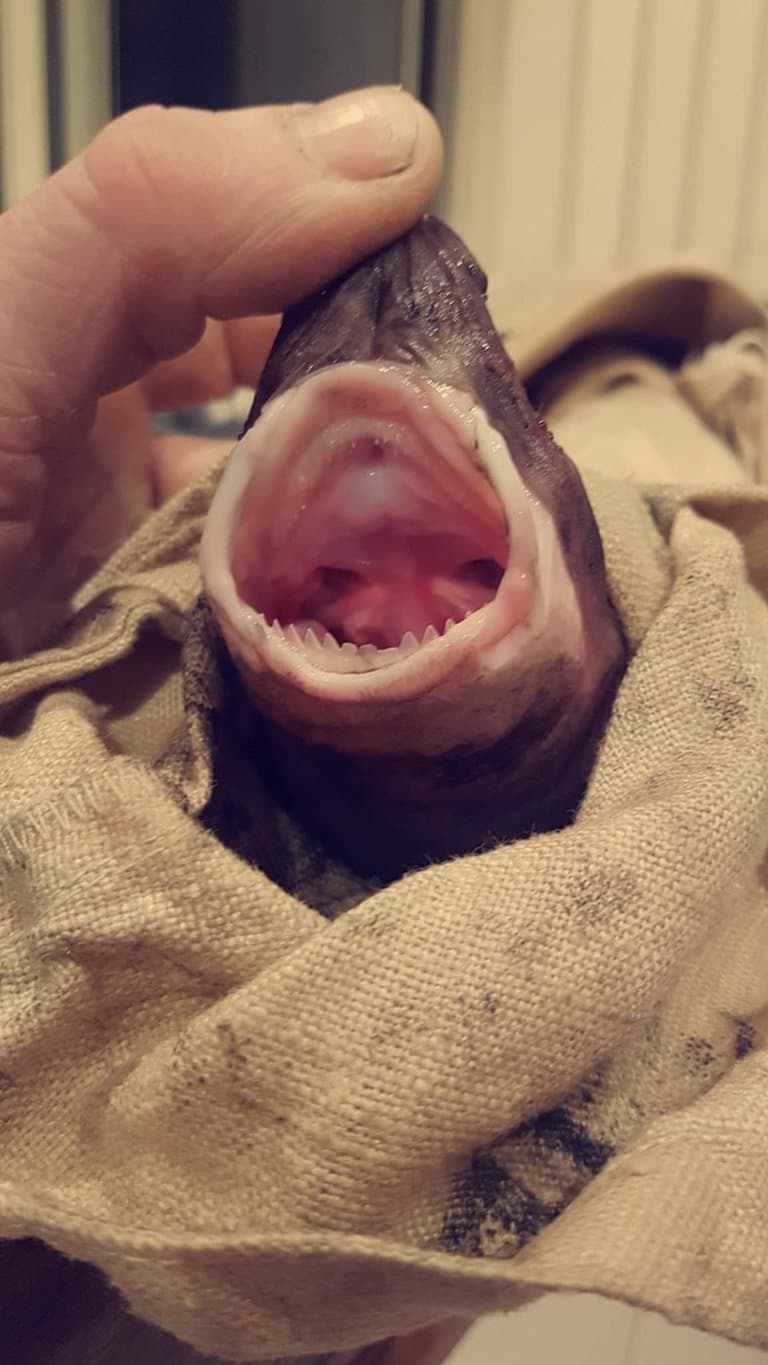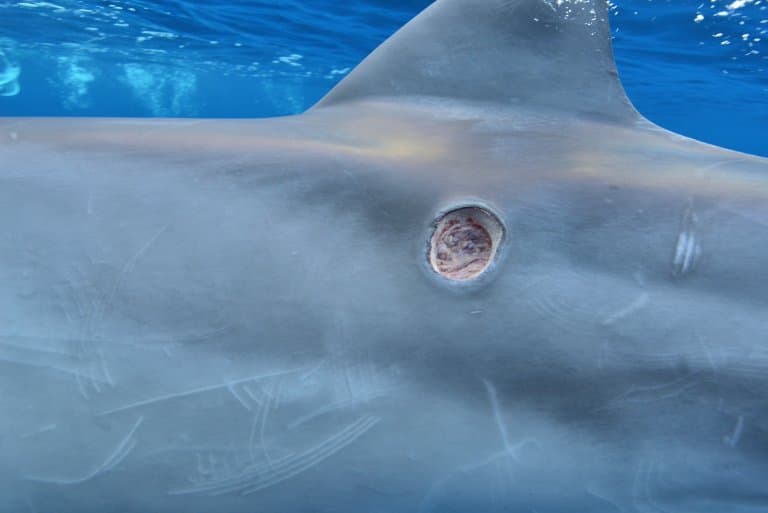Cookiecutter Shark Profile
The most frightening fish in the ocean is no longer Jaws. Instead, you now have to worry about a glow-in-the-dark-piranha-shark with green eyes, that bites holes in great whites.
The cookiecutter shark, also known as the cigar shark, smalltooth cookiecutter, smooth or luminous shark, is a species of small squaliform shark, that lives in warm waters worldwide.
These sharks are named after their feeding method of gouging round plugs out of much larger animals, as if cut out with a ‘cookie cutter’.

Cookiecutter Shark Facts Overview
| Habitat: | Warm, oceanic waters; from surface to 3,500m |
| Location: | Circumtropical |
| Lifespan: | Unknown |
| Size: | Up to around half a meter (22 inches) |
| Weight: | Unknown |
| Colour: | Grey-brown, with a green glow |
| Diet: | Anything free-swimming |
| Predators: | Larger fish? Deep sea monsters |
| Top Speed: | Unknown |
| No. of Species: | 1 |
| Conservation Status: | Least Concern |
Cookiecutters are the smallest, cute-name-havingest covert little glow-in-the-dark demons that you wish you’d never heard of.
They’re formidable both as parasites and hunters, killing alone or in schools and have the fearsome advantage of being tiny and fast.
They may also use a unique form of lure to bring giant predators within striking distance, and specialised flesh-removal mouthparts to subsequently gouge pieces out of them.
Interesting Cookiecutter Shark Facts
1. Cookiecutters are small with cigar-shaped bodies
This might be one of the scariest things about this animal. A deep-sea giant is something everyone can get their heads around, but a school of tiny little flesh-eaters evokes a distinct quality of panic.
The largest females grow to less than 50cm long, usually closer to 40cm, yet when they’ve been brought up and examined, they’ve been found to contain plugs of flesh and blubber from some of the largest animals in the ocean.
These little sharks occupy the murky depths all around the tropics, ranging from the surface all the way down to over three kilometres deep. And they should really stay down there because, being this weird, they have no business at all up with the normies. 1

2. They glow in the dark
But before we get to how they accomplish this, let’s focus on another bizarre quirk of this shark: its ability to produce light.
At 3,500m down, it can get pretty dark. But these fish are specialist deep-sea demons and therefore have a string of adaptations to their advantage. First of all, their livers are 35% of their mass, filled with low-density fats that allow them to just sit there in the dark, not floating, not sinking, just waiting…
Then, it has enormous eyes for its size, which can pick out the faintest of glows, and an elongated tail fin designed for immediate acceleration towards – not away from – its potential predators.
But this shark glows green like a cheap Halloween mask and has the strongest case of luminescence known for sharks. It glows so hard that even after you kill one, it’ll be up to three hours before the light in its dead eyes goes out.
Some of this glow is suggested to be effective at cancelling out its silhouette – by matching the background light levels at certain depths, the shark doesn’t cast a shadow on your retina.
Many deep-sea predators hunt for prey the same way Hubble hunts for planets: wait for it to pass in front of the light. So, becoming the light is a great way to ruin that approach. This shark’s vertical migrations may align with the light levels during the day, allowing it to maintain its disguise throughout the shifting light cycles.
But some of this luminescence has an even more sinister application.
3. They have a lure
There is an area around the collar of this fish that has no photophores in it. This creates the illusion when viewed from a particular angle, of the silhouette of a small fish. When these sharks get together, which they are thought to do, this would present a hungry giant with the image of a school of small, tasty morsels.
If this is the case, while everything else in the ocean is doing its very best not to draw the attention of invisible monsters from below, this shark is actively encouraging them.
This remarkable lure would be the only one of its kind known, as it would be using the lack of light, rather than the light itself, to mimic a prey item.
Again, it’s worth mentioning that this lure is designed to attract upward-looking predators, the very concept of which is just bone-chilling.
And these sharks aren’t suicidal, they have a plan. 2
4. Spud gun faces
For those of us born before Call of Duty, shooting at our friends involved braving the wild outdoors; guns made use of tiny explosive bits of paper, water, BBs or a pump mechanism used for firing out chunks of potato.
The cookiecutter shark is so-named for such a mechanism. Its jaws are shaped like hole saws and are used very much in the same manner.
As difficult as you might have thought it to be to feel sorry for an “upward-looking predator”, these poor saps are lured directly into the firing line of a multitude of these little hole saws, each of which is capable of punching out a 10cm hole, 2.5cm deep, in their softest of tissues.
Behind these teeth are suction-cup lips that create a nice seal and a muscular tongue which serve to suck out the plug of flesh.
They replace all their lower teeth at the same time, unlike many sharks that replace them individually. This ensures there’s always a sharp surface. And with this small weapon, they’re able to take on more or less everything in the ocean. 3
5. They’ll punch holes in anything
While it does kill, this animal is generally considered a parasite of large animals. It’s a very difficult animal to study, partly on account of it being too frightening to go near, but mainly because it’s small and elusive down there in the ink.
But scar patterns on large animals can give a clue to its survivors, at least. From these, it seems like the cookiecutter has a great preference for swordfish and Opah. It’s also possible that they hunt alone – most fish with scars only have one. But this could equally mean that they’re very successful pack hunters and only those who get away quickly survive.
But more than fish, almost every medium-to-large oceanic animal who lived in their habitat showed signs of attack from these fish. The list of victims is staggering.
Cetaceans, pinnipeds, dugongs, sharks, rays, fishes, and even squid, all have been found with characteristic holes punched out of them. It’s now thought that the shark also eats small squid entirely, as well as copepods bristlemouths and other small prey.

6. Including humans
In 1992, a drowned fisherman was hauled out of the ocean in Hawaii with cookiecutter holes in his back. While this was likely a case of carrion-scavenging, there have been confirmed accounts of attacks on live people, too.
Shipwreck survivors, oceanic photographers, and even long-distance swimmers have all been attacked, some by schools of these sharks.
In 2021, some crazy Russians tried to sail around the world in an inflatable trimaran. 800km off the coast of Australia, some Cookiecutter sharks attacked it, punctured it, and they had to be rescued by a cargo ship.
So, for now, a hungry school Humbolt squid is the only thing more frightening than a team of these sharks. But humans are small fry in the ocean. This alien sucker even takes on some of the most accomplished marine predators. 4
7. They prey on Great whites
So much for the “Apex Predator” accolade, not only do the killer whales chow down on great white sharks, but even a 40cm shark can put one in its place.
At least one White shark has been found in Mexico with cookiecutter bites on its mouth. You’d be rooting for the terrifying giant in this situation, but it’s unknown how the bout turned out.
It’s thought that the vertical migrations of these prey animals overlap with those of the tiny shark, which brings them into contact with one another.
It’s clear that this is a very successful strategy for the little fish, and makes you wonder what could possibly be keeping their populations in check… 5

8. They’re seemingly not threatened
Not all that much is known about their populations, but the fact that most people can enter the ocean without incident does suggest that these sharks haven’t taken over the world yet. This throws up the question: what’s stopping them?
They’re pulled up by nets from industrial fisheries, just like every other animal in the ocean, but that’s not enough to keep them at bay, and besides, they existed in the ocean long before we had boats.
There must be animals that are somehow not susceptible to their cheeky lures, or perhaps even more dangerous and scary, that lurk below, picking them off at a high enough rate to keep the rest of the animals safe.
And that’s not a question to ponder before going to bed.
Cookiecutter Shark Fact-File Summary
Scientific Classification
| Kingdom: | Animalia |
| Phylum: | Chordata |
| Class: | Chondrichthyes |
| Order: | Squaliformes |
| Family: | Dalatiidae |
| Genus: | Isistius |
| Species: | Isistius Brasiliensis |
Fact Sources & References
- Andrew E. Jahn (2013), “Notes on the Pelagic Squaloid Shark Isistius brasiliensis”, Taylor & Francis Online.
- Edith A. Widder (1998), “A predatory use of counterillumination by the squaloid shark, Isistius brasiliensis”, Springer Link.
- Donald W. Strasburg (1963), “The Diet and Dentition of Isistius brasiliensis, with Remarks on Tooth Replacement in Other Sharks”, JSTOR.
- Kevin McMurray (2019), “Rare Cookiecutter Shark Bite in Hawaii”, Tracking Sharks.
- Mauricio Hoyos-Padilla (2013), “Observation of an Attack by a Cookiecutter Shark (Isistius brasiliensis) on a White Shark (Carcharodon carcharias)”, BioOne Digital Library.
